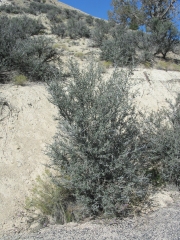
Common Names curlleaf mountain-mahogany
Family Rose
Flower Color Green-white
Plant Type Evergreen shrub
Native Yes
Weed No
| Home | Plant List |
 | Cercocarpus ledifolius Common Names curlleaf mountain-mahogany Family Rose Flower Color Green-white Plant Type Evergreen shrub Native Yes Weed No |
Curlleaf Mt. Mahogany
Curlleaf Mt. Mahogany (Cercocarpus ledifolius) is a shrub, with a woody aspect to the plant stock and branches. Ledifolius grows in very few different types of environments, which could be considered high plains deserts or the lower steppe of the mountainous forests. These environments are usually divided because of the understory perennial grasses, which are commonly Idaho fescue (Festuca idahoensis) or Blue bunch wheat grass (Agropyron spicatum). They are very much the same grasses but Festuca idahoensis grows in a more rocky mountainous environment and in a more clumpy/spotted growth pattern, while Agropyron spicatum is more known for high plains range lands and has a more condensed growth pattern.
Cercocarpus ledifolius is common to a rocky mountain steppe environment just below the tree zones. Ledifolius grows to be about 5 - 15 feet tall and is commonly seen among spotted Junipers (Juniperous occidentalis) and Ponderosa pine (Pinus ponderosa). Ledifolius is a major nutrient for deer and elk in the winter months. Studies have been done on the Ledifolius twigs, in order to determine whether it is regenerating for next years food source (Journal of Range Management 56(6) November 2003).
Carcocarpus ledifolius is an evergreen shrub of the Rosaceae family. The species Ledifolius is divided into two varieties which are easily mistaken for one another, due to the most identifiable leaf characteristic of this species. The best way to distinguish between the two varieties is to look at the leaf width; the first variety ledifolius has a blade 4 – 10 mm wide, while the variety intercedens has a blade mostly < 3 mm wide. Both varieties of Curlleaf Mt. Mahogany have a reddish – brown bark that with age turns grayish-brown and becomes furrowed with plate-like scales.
The fruit is a long twisted plume, with a distinctive curl in it. It is said to resemble a pipe cleaner. (D. L. C. 12-02-04)
Distribution in Malheur County, Oregon: Here we find curlleaf mountain-mahogany on sloping ground starting at elevations above about 4,000 feet before the transition from sage to ponderosa pine and into the transition to ponderosa pine. In sites that do not support forest growth, curlleaf mountain-mahogany can be found at 7,000 feet or higher in the Owyhee Mountains. A prominent curlleaf mountain-mahogany site in Malheur County is Mahogany Mountain SE of Leslie Gulch and N of Jordan Valley. Wildlife grazing has a large effect on curlleaf mountain-mahogany and it is an important brouse plant. Clint Shock, August 12, 2005
curlleaf mountain-mahogany